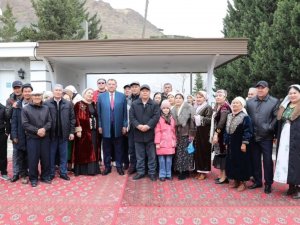Specialists of the “Turkmen atlary” State Association, lecturers and students of the Turkmen Agricultural University, representatives of other relevant structures, recently visited the Balkan province on a business trip.
The purpose of this trip was to study the peculiarities of behavior and habitat of steppe squirrels living in this region. Their herds are now found in the etrap of S. Turkmenbashi and, in particular, on the coast of the Caspian Sea, in the coastal strip near the Guvlymayak Gengeshlik, as well as in the villages of Karshi and Ajalma in the vicinity of Garabogaz and in the plains of Yangala.
During the working trip, pictures of these horses were taken, their habitats were registered, and the plants they feed on were also studied. It has been established that in the winter the horses feed on pollen, in the spring - mint, sedge and oatmeal, and in the summer - the dried spring grass.
Adapted to the field conditions, horses are divided into large and small groups, each of which is considered a separate family. Heads of families - stallions - provide protection of all horses in herds and determine the territory of their habitat. For example, several family herds of wild squirrels have been recorded on the plain of Yangala.
The members of the scientific group studied the main places of their habitat, origin and exterior, as well as the characteristics of the pastures where they graze. Basically these horses graze in steppes, use for drinking water collectors with drinking water, springs.
As already noted, in the autumn and winter months, steppe horses feed mainly on the pastures of this area with polynesia and trioostrennitsa, drink water daily or through the day, sometimes after two or three days. In the summer, wild boars come to the water every day. It should also be noted that natural water bodies are mainly used as rainwater source, mainly rainwater accumulation sites.
According to locals, in case of lack of water, the horses come to the Caspian Sea by water. The lots quickly get to their feet and join the flock.
Steppe horses have a small but strong physique, a large head, a flat forehead, an elongated tail, a medium-length neck, a strong waist and a large round shape. Compared to domestic horses, they have more thickened legs and strong black hooves.
The members of the group, which was created to study the origin and behavior of these beetles, found that among them there are horses of sledgehammer, sive, raven, and mule. There are slippers with stains and marks, including on the feet. During the study, newborn foals were also observed.
In accordance with the website of the press service, the data collected during the working trip to the Balkan velayat are currently being analyzed, and samples of imported fodder plants are being studied in the laboratory.
In general, this project will be another important step towards solving the tasks of comprehensive scientific study of the flora and fauna of Turkmenistan, preserving in the original form unique corners of Turkmen nature for future generations.













